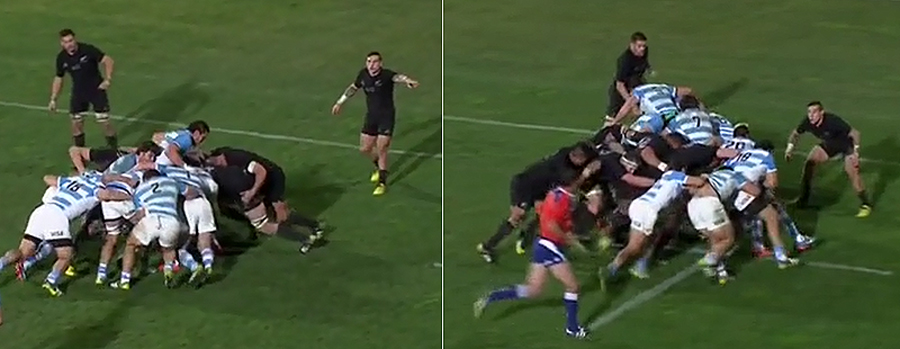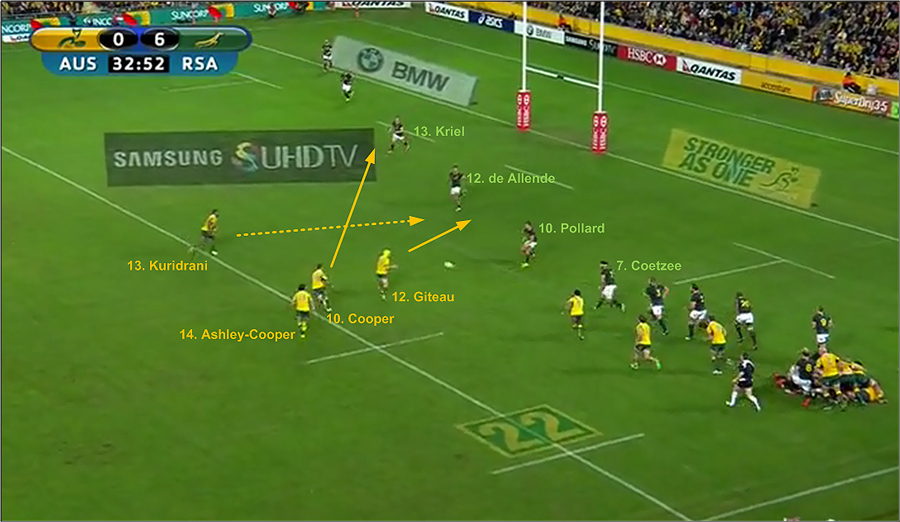|
Three Points
Lineout drives about brain as much as brawn
Brett McKay
July 22, 2015
Australia 24-20 South Africa (Australia only)
The rugby world is in for a real treat if the rest of this Rugby World Cup season plays out half as well as the first weekend of Rugby Championship Tests. New Zealand were very good in what may well be Richie McCaw and Dan Carter's last game in Christchurch, but still you had to be impressed with the way Argentina came back at them in the second half - and maybe even exposed a little chink in the almighty black armour. The Wallabies, meanwhile, will take a lot of confidence out of their last-ditch come-from-behind win over South Africa in Brisbane, but supporters are now taking medication for newly-diagnosed heart conditions. Here are three points to take away from the weekend
Short-side lineout drive trickerySteve Hanson may think the lineout drive is "boring rugby", but it's fair to say that his All Blacks now are going to face more rather than fewer attacking mauls in the corner after Argentina's 10-minute period of success in the second half.

Rolling mauls now are as much brain as brawn © Getty Images
Enlarge
New Zealand 39-18 Argentina (Australia only)
%]In the image on the left, above, we can see Pumas skipper Agustin Creevy (No.2) joining the maul; by this stage, he'd already noticed that All Blacks hooker Codie Taylor (left) was defending in the scrum-half position with just Aaron Smith (right) and Jerome Kaino (out of shot) on the short side. Smith actually appears to be telling Kaino to hold his position, but the back-rower joins the maul himself after Creevy. So Creevy already knows where the maul needs to go by the time he joins the maul and the Pumas shortly after start dancing the maul toward the corner, as we can see in the shot on the right. Smith was faced with four Pumas peeling off towards him, and Creevy crashed over for his first Test try. Hansen praises underdone Dagg
%]The Pumas had another crack in the 62nd minutes, when the All Blacks kept Kaino out of the maul with Charles Piutau also back on his wing. That maul did rumbled forward then peeled to the open side, leaving Taylor trying to stop a maul on his own. Creevy had try number two. Former All Blacks front-rower Craig Dowd wrote in his excellent column on Tuesday that "the All Blacks were technically very poor in the way they tried to stop the Pumas' drives", saying that a team has "got to have the right attitude and work together, and you have got three seconds to stop the rolling maul". "You either put it down, you put it out or you get it going backwards. If you don't do that, and do it together as a pack, then you are going to be in trouble." Hanson should probably ready himself to be bored a lot more at Ellis Park this weekend.
What to make of the Wallabies win?Once the aforementioned medication has finally kicked in, Wallabies supporters will be thrilled with the 24-20 win over the Springboks. But considering they coughed up the ball in a similar position only 90 seconds before Tevita Kuridrani's 82nd minute try, it was a close run thing. Much has been made of the impact of the Wallabies bench, particularly Scott Sio and Greg Holmes up front, lock James Horwill, David Pocock packing down at the unfamiliar role at No.8, and Matt Toomua in midfield. But how much of their impact was due to their genuinely good performances, and how much was a result of the comparatively little impact from South Africa's bench? The Springboks had scrum and breakdown ascendancy, but that started swinging the other way once the starting front-row was hooked before the 50th minute. By the end of the game, the Wallabies were on top on both fronts. Wallabies had right attitude - Cheika
%]And the stats sheet tells a funny story, too. I mentioned on this week's Scrum5 podcast that South Africa dominated the possession and territory splits in the first half - 56% and 59% respectively - but it switched violently Australia's way in the second half - 79% possession and 86% territory. In all my time covering rugby, I don't think I can recall a territory split as low as 14% for a half of football. Expecting the other game stats to similarly flip, we put our 'guys' at Opta Sports on the case for the rest of the match stat splits. And that makes for just as interesting reading. Australia made eight clean breaks for the match, but only two in the second half. They beat 26 defenders and made seven offloads for the game, but only 14 and four respectively in the second half. It doesn't really read like a team who had virtually all the ball in the second half. Australia did concede fewer turnovers and won more scrums in the second half - even winning a tight-head, too - confirmation that the breakdown and scrum dominance changed hands. So while the win was great, there are still plenty of questions for Michael Cheika to address this week in Mendoza. There's a reasonable argument to be made for the side that finished in Brisbane to start in Argentina, but it won't be that simple; rugby rarely is. Though the 'Pocock or Hooper' question might have a simple answer: just play both.
Wallabies set-piece play worth revisitingAdam Ashley Cooper's try in the first half at Suncorp Stadium will have delighted Michael Cheika, and the play had the hallmarks of his new attack coach, Stephen Larkham, all over it. Just beyond the first half an hour, the Wallabies had an attacking lineout deep in the South African 22 after Willie le Roux had shanked horribly a clearing kick. Scott Fardy took the clean throw and the maul formed around him quickly, simultaneously making a few metres. As the Springboks bodies went to ground to halt movement, Michael Hooper released the ball to Will Genia, who fired a pass quickly to Matt Giteau at first receiver.

Tevita Kuridrani was key in his role as dummy runner © Fox Sports
Enlarge

Adam Ashley-Cooper bounced over all but untouched for the try
© Getty Images
Enlarge
The still above shows the set-up nicely. Giteau draws Handre Pollard toward him as he takes the pass but keeps heading toward Damian de Allende, who knows already that he's in trouble with Kuridrani running toward the same gap on the outside-in line he ran on numerous occasions for the Brumbies this season. Kuridrani's run is good, and Giteau fires the ball out the back to Cooper, who's heading towards young outside centre Jesse Kriel. Pollard managed to adjust and he pushed de Allende out onto Cooper, but that in turn opened the gap on the inside for Adam Ashley-Cooper to bust through and score. Note above, by the time Giteau had the ball, the closest Springboks forward, flanker Marcel Coetzee, is nearly 10 metres behind him; the move was all about the Wallabies' speed and execution from there, and it worked wonderfully. Against Argentina, this move could also similarly work from an attacking scrum if the Wallabies can draw Los Pumas into a contest to keep their flanker bound and if Moore can then get a quick strike. And it could work from scrum or lineout against New Zealand two and three weeks later, but the move may need a touch more width to get away from the All Blacks' faster loose forwards. But it's too good a move to leave in the draw. Keep an eye out for it, and variations of it, in the coming weeks. © ESPN Sports Media Ltd
|
Live Sports
Communication error please reload the page.
-
Football
-
Cricket
-
Rugby
-
- Days
- Hrs
- Mins
- Secs
F1 - Abu Dhabi GP
Abu Dhabi Grand Prix December 11-131. Max Verstappen ()
2. Valtteri Bottas (Mercedes)
3. Lewis Hamilton (Mercedes)
4. Alexander Albon ()
5. Lando Norris ()
6. Carlos Sainz Jr ()
-
ESPNOtherLive >>
Golf - Houston Open
Snooker - China Open
Tennis - Miami Open

